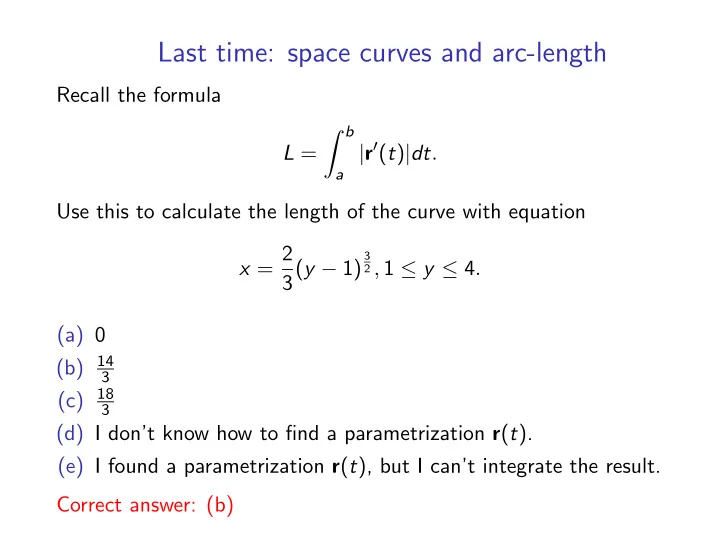

Last time: space curves and arc-length Recall the formula ∫︂ b | r ′ ( t ) | dt . L = a Use this to calculate the length of the curve with equation x = 2 3 3( y − 1) 2 , 1 ≤ y ≤ 4 . (a) 0 14 (b) 3 18 (c) 3 (d) I don’t know how to find a parametrization r ( t ). (e) I found a parametrization r ( t ), but I can’t integrate the result. Correct answer: (b)
Cycloid Tautochrone (“same time”) Brachistochrone (“shortest time”)
Integration in one variable Fix g : [ a , b ] → R . ∙ Divide [ a , b ] into n subintervals [ x i − 1 , x i ] of equal length ∆ x = b − a n . ∙ For each i choose any x * i ∈ [ x i − 1 , x i ]. ∫︂ b n ∑︂ g ( x * g ( x ) dx = lim i )∆ x n →∞ a i =1 (assuming the limit exists and is independent of the choices of x * i ).
Geometric interpretation of integration ∙ ∫︁ b a g ( x ) dx = ( b − a ) × (average value of g on [ a , b ]) . ∫︁ b ∙ If g ≥ 0, a g ( x ) dx gives the area under the graph of g over the interval [ a , b ]. ∙ If g ( x ) is the linear density of a straight piece of wire with ∫︁ b endpoints a and b , then a g ( x ) dx calculates the total mass of the wire. ∙ Furthermore, the point x ∈ [ a , b ] corresponding to the centre of mass of the wire is given by ∫︁ b a xg ( x ) dx x = ∫︁ b a g ( x ) dx
Practice with integration Let C be the semicircle given by x 2 + y 2 = 1, y ≥ 0, and consider f ( x , y ) = y . ∫︁ Calculate C fds , using the parametrization r ( t ) = ⟨ cos t , sin t ⟩ , t ∈ [0 , π ]. (a) 1 (b) − 1 (c) 0 (d) 2 (e) I don’t know how. Correct answer: (d)
Studying a wire Suppose we have a wire bent in the shape of the semicircle C given by x 2 + y 2 = 1, y ≥ 0. Assume the wire has constant linear density ρ . Use geometric intuition to guess the centre of mass from the options below. (a) (0 , 0) (b) (0 , 1) (c) (1 , 1) (d) ( 2 π , 2 π ) (e) (0 , 2 π ) Correct answer: (a)
Recommend
More recommend